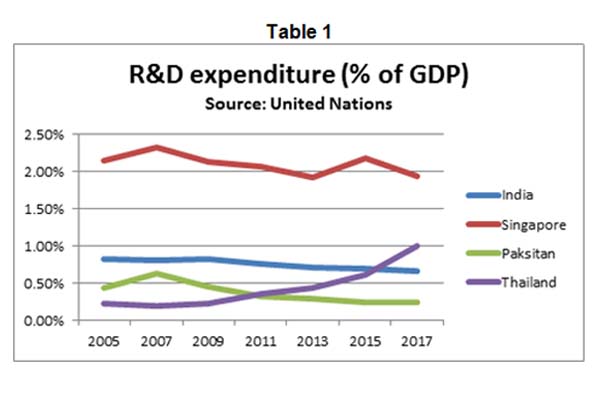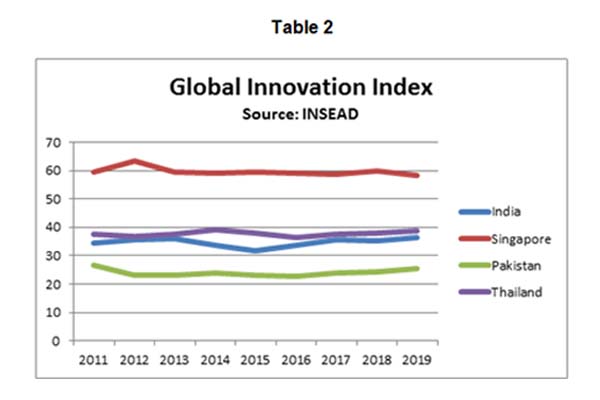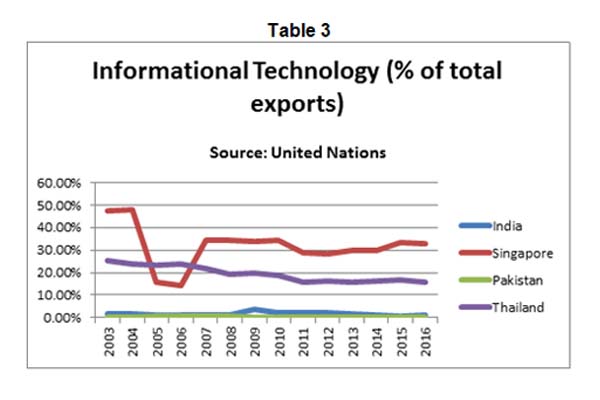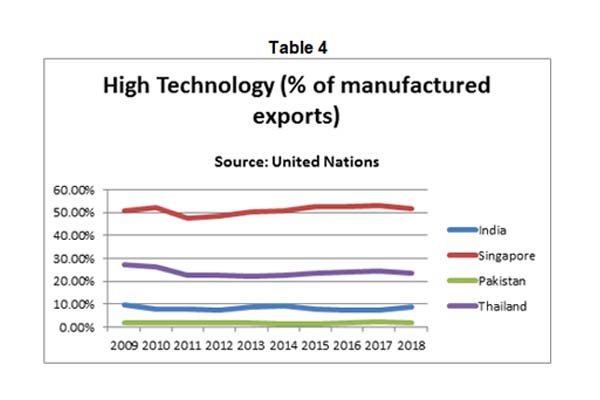A continued investment in the technology sector often distinguishes developed nations from developing nations. An increased focus on this sector not only yields positive dividends on growth but also facilitates headway on the development front. This is why countries – like China – which house an overwhelming proportion of the competitive high-tech industry enjoy long-term economic prosperity in the wake of cost-efficient outputs that nimbly tap into both local and foreign markets.
However, technology is not an input that any country can code into its economy. It results from sustained investment in Research and Development (R&D), which opens the window for disruptive innovation. R&D is simply a systemic way to augment the stock of knowledge over time. It transforms one into a knowledge-based economy that can reap the fruits of innovative goods and services. Innovation contributes to the economy by lessening the production cost (efficiency) or ameliorating the quality and quantum (productivity). These outputs are exported worldwide to earn meaningful foreign reserves and finance the import of capital goods.
Despite the guarantee of propitious returns, Pakistan has shown a baffling lack of interest in R&D spending over the years. From agriculture to industry to services, we pursue age-old techniques in the hope of a different outcome. The absence of the required will to enhance technological capabilities is why Pakistan stumbles to secure a firm-footing in the global business domain. However, Pakistan can benefit from increased productivity during the agricultural harvest, value-added industrial output, and state-of-the-art services if it embarks on the route of a knowledge-based economy. This also has a positive spill over impact on public health, education, and infrastructure. In this way, Pakistan will be able to narrow the economic gap with developed countries.
To illustrate this point, let us compare Pakistan with three other Asian countries: Singapore, Thailand, and India. R&D is the prime component of knowledge capital, which triggers innovation and leads to technological advancements. Yet, Pakistan’s R&D expenditure to GDP is less than all the three of the aforementioned countries. It averaged a meagre 0.38% from 2005 to 2017 compared to 0.76% of India, 0.44% of Thailand, and 2.1% of Singapore.

Corporations in Pakistan have been reluctant to invest in R&D because they consider it too expensive given their modest returns on productivity. They fail to understand that such investments do not offer immediate results. Instead, the pay-off in the form of increased outputs usually comes after a lag of a year or two because the employees take their time to integrate with and adjust to these novel methodologies. Private companies have also paid little heed to this aspect since the social returns of R&D and innovation outweigh their private returns. Hence, they consider it the responsibility of the state to engage finances in R&D. This can be best described as market failure owing to the diffusion of knowledge beyond the inventor’s control. Considering both the reasons, private R&D is well short of a socially optimal level. This, together with a lack of public intervention to address market failure, has adversely impacted Pakistan’s cause.
Resultantly, Pakistan continues to trail these three countries with regards to innovation. It was recently ranked in the bottom quintile on the innovative propensity by Bloomberg Economics because of the deplorable business climate, institutional quality, technology infrastructure, and human capital. Pakistan averaged roughly 24 points in the Global Innovation Index (GII) from 2011 to 2019 against 35 points of India, 60 points of Singapore, and 38 points of Thailand.

Innovation resulting from R&D is attributed to the enhancement of the absorptive capacity of businesses in any country. The firms gain the capability to assimilate and make use of high-tech knowledge to make their products competitive with those of rival countries. Paralleling many African countries in innovative capacity, Pakistan has fared abysmally in the export of information technology (IT) and high-tech services to the world.


High-tech goods and services are the outcome of aggressive scientific research spending in telecommunication, computer, electronics, aerospace, electrical machinery, chemistry, and pharmaceuticals. These high-tech exports can help countries to withstand the worst economic slumps. For this reason, high-tech production is regarded as a viable solution to sustain economic growth.
Hence, Pakistan needs to adopt a research-based culture before we become unmanageably distant from other nations in terms of innovation. The Higher Education Commission (HEC) can collaborate with and offer incentives to private universities to promote research in both the social and natural sciences. Additionally, the state should task its research institutions to come up with modern and prudent approaches to agriculture and manufacturing so that we are able to improve our dismal productive capacity.



COMMENTS
Comments are moderated and generally will be posted if they are on-topic and not abusive.
For more information, please see our Comments FAQ